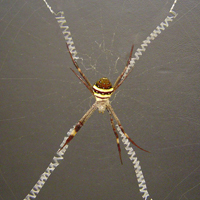A spider that decorates its web perpendicular to the web plane

All claims expressed in this article are solely those of the authors and do not necessarily represent those of their affiliated organizations, or those of the publisher, the editors and the reviewers. Any product that may be evaluated in this article or claim that may be made by its manufacturer is not guaranteed or endorsed by the publisher.
This paper examines and describes web decorating behavior by juveniles of the orb-weaving spider, Trichonephila antipodiana. Decorations consist of a three-dimensional ‘tube’ of silk line scaffolding within which detritus, prey items and moult exuviae are laid perpendicular to the web plane, extending from the central sticky web forward and backward to the dorsal and ventral barrier webs. Complementarity with barrier web construction, combined with the vulnerability of this ontogenetic stage, suggest that the primary function of the decorations is as an anti-predator device. Various lines of evidence support the view that the fundamental structural purpose of the decorations is perpendicular extension: (1) median web residency time was significantly greater for juveniles with decorations ≥ 1 cm in size; (2) detritus was the primary contributor to decoration length; and (3) examination of the in-laying technique for prey inclusions found them to be ‘unnecessarily’ dismembered and stretched out along the decorative plane. Although there is probably some degree of interdependence between predator avoidance and prey catching success, extension as a property fits most consistently within a defensive interpretation of function in so far as it confers either distance from and/or interference with predators.
PAGEPress has chosen to apply the Creative Commons Attribution NonCommercial 4.0 International License (CC BY-NC 4.0) to all manuscripts to be published.

